|
|
| Overview |
The PADS Logic Adapter can be used to:
The Adapter will read data from the Omnify database to perform updates and verification routines.
When the Adapter is invoked, CADKit will begin communicating with the PADS Logic application.
If PADS Logic is not already running, CADKit will automatically launch PADS Logic.
When using the Adapter, the user can select from 3 different operating modes:

| Add Components |
Allows you to add components to a Logic schematic with properties of an item from the Omnify database. |
| Update Components |
Allows you to update previously placed components on a Logic schematic with properties of an item from the Omnify database. |
| Validate Design/Components |
Compares properties of components on a Logic schematic with items in the Omnify database to determine if a unique match exists. |
|
 |
Adapter Form Basics |
Top |
|
The PADS Logic Adapter form contains the following areas:

| Banner |
Displays PADS Logic connectivity, version, and current design information. |
| Operating Mode |
Allows you to select from the various operating modes |
| Saved Filter Selection |
Allows you to select from a saved filter/parameters |
| Toolbar |
Access to common Adapter commands |
| Search Results |
Displays the results of the Omnify database search |
| Search Parameters |
Allows you to search the Omnify database and filter the results list based on specific data field values |
|
 |
Symbol Mapping |
Top |
|
The PADS Logic Adapter uses the "Symbol Field" setting to determine which symbol will be placed on the schematic.
The "Symbol Field" is mapped to a specific Omnify field (usually an attribute field) in the CADKit Options dialog box.
Select the Options command from the Tools menu.

From the CADKit Options dialog box, select the PADS Logic Fields option/page.

The PADS Logic Fields page will display all available item data fields in the Omnify database.

To assign the "Symbol Mapping" field, select the Omnify field that contains the PADS Logic symbol names.
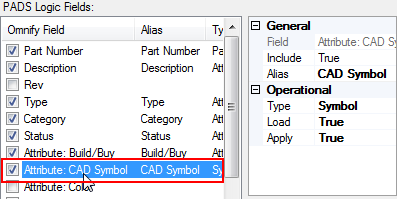
Notice that the Properties section will display the current field information for the selected field.
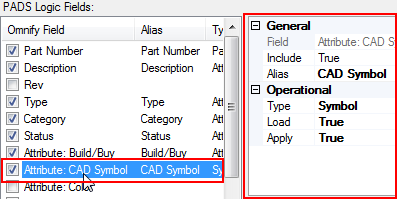
To assign the field as a "Symbol" field, set the Type option to: Symbol.
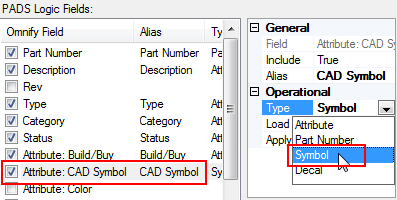
Refer to the next section for more information on field/attribute options.
|
|
|
When adding, updating, or validating schematic components, the Adapter will read and apply component attributes based on the Omnify fields.
Each field can be assigned a field type that will indicate a specific operation and behavior to the Adapter.
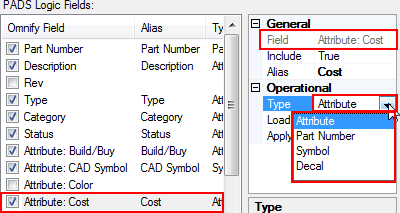
| Attribute |
Field will be used as a standard attribute field in PADS. |
| Part Number |
Defines the field that contains the Omnify Part Number (used when verifying designs and uploading BOMs). |
| Symbol |
Defines the field that contains the PADS Logic Part Type/Symbol. |
| Decal |
Defines the field that contains the PADS Decal. |
Note: Field Types are enabled and modified in CADKit Options dialog box.
Refer to the User Options section for more information on setting field types.
For each field, you can also set the following:
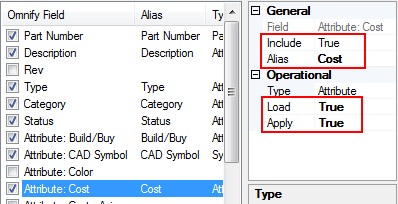
| Include |
If this option is enabled, the system will display the field in the search results and search parameters lists |
| Alias |
You can alias the field name to apply as a different attribute name |
| Load |
If this option is enabled, the Adapter will read and include this field as a search parameter when updating or validating components. |
| Apply |
If this option is enabled, the Adapter will apply this field as an Attribute on the component. |
|
 |
Searching the Database |
Top |
|
When adding or updating components on a PADS Logic schematic, the database search list will be displayed on the Adapter form.
The Toolbar will display common search functions.

The Search Results area will display the results of the search.
To perform a search, you can select the Add Components or Update Components mode.

You can define search parameters by typing a search value in the Search Parameters list.

To assign the value and perform the search, you can click on any other area of the form.
The Search Results list will update to display the matching database items.
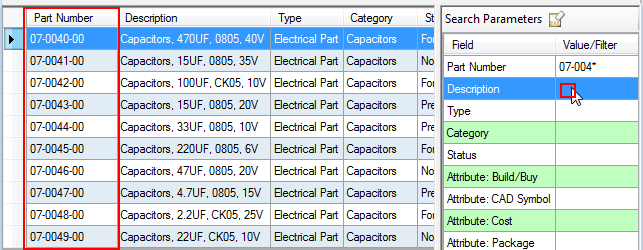
You can use search wildcards (* or %) on any of the fields.
Note: specifying a blank value will clear the existing search parameter for that field.
You can clear all search parameters using the Clear All toolbar button.
You can sort on any column by clicking the Column header hyperlink.

The sort icon will appear to the right of the currently sorted column.
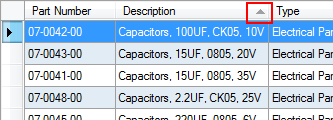
CADKit allows you to save search parameters to be recalled for searching or for providing a search foundation.
Saved filters will appear in the Filter drop list.

Once search parameters have been defined, you can create a filter by selecting the Save As Filter button from the Search Parameters toolbar.
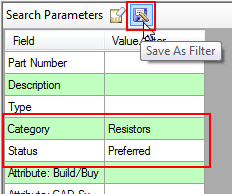
You will be asked to provide a name for the filter.
Once the name is specified, click the OK button to create the filter.
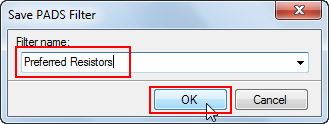
The saved filter will appear in the Filters drop list.

Selecting a filter will assign the stored parameters to the current search parameters list.
You can delete a filter by first selecting the filter and then clicking the remove icon next to the drop list.

You will be asked to verify the removal.
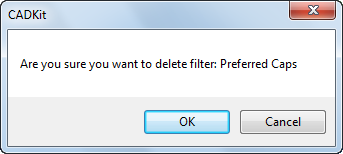
|
 |
Adding Components |
Top |
|
To add components to a PADS Logic schematic from CADKit, select the Add components operating mode.

Refer to the Searching the Database section for more information on refining your searches.
To add a component to the schematic, you can either double-click on any row or select the row and then click the Add toolbar button.

You can now move the cursor to the schematic window.
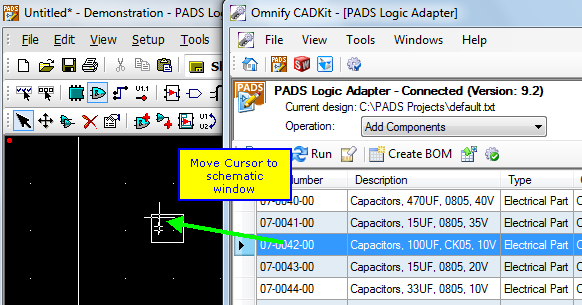
The new component will be attached to the cursor.
Click the left mouse button in the schematic window to place the component.
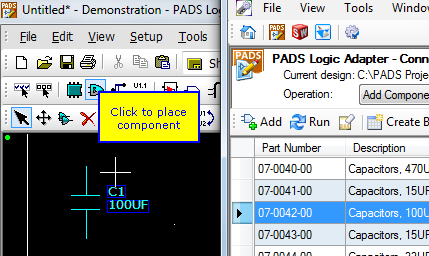
The system will look at the Symbol field setting (User Options) to determine which column contains the Part Type name to be used when placing the component.


To validate the component Part Type, use the Query/Modify (or Properties) command to display the component properties in the Logic schematic.
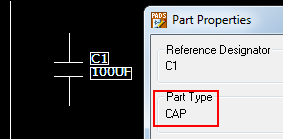
If the part type specified in Omnify does not exist in your library search path you will receive the following error:
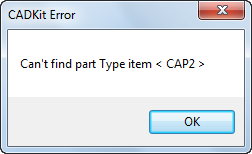
If this error appears, check your library settings to validate that the desired part type is available in your library listing.
When adding the component to the schematic, CADKit will apply all desired field/field values from the view as attributes on the component.

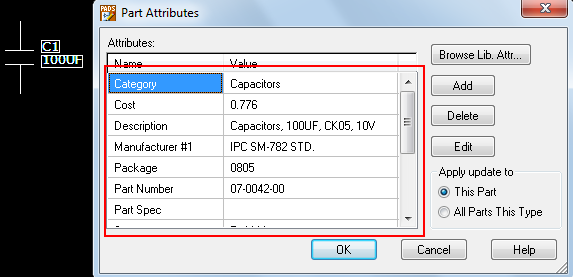
The attributes applied to the component will be the attributes defined as "Apply" Fields (refer to the Attributes section).
|
 |
Updating Components |
Top |
|
To update components that have already been placed on a Logic schematic, select the Update components mode.

Note: a components (Update:) drop list will appear in the toolbar.
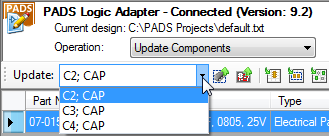
By default, CADKit will list the components that are selected in the schematic.
You can load the Update drop list with the selected or all design components.
To load the Update drop list with the selected component(s), first select the desired component(s) in the schematic and then click the Load Selected Components toolbar button.

To load the Update drop list with all design components, click the Load All Components toolbar button.

The Update drop list will display the Reference Designator and Part Type for each component.

Once a component is selected in the drop list, the system will read all "Load" attributes from the schematic and use them as search parameters.
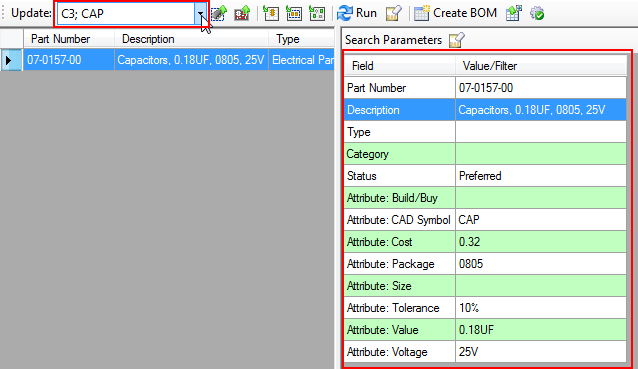
The system will then display all matching results in the Search Results list.
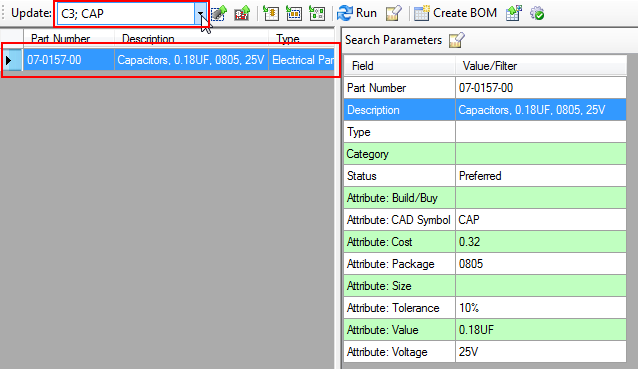
You can use the searching techniques discussed in the Searching the Database section for more instructions on expanding or narrowing your search results.
When updating the components, you can update the loaded component (component selected in the Update drop list, all "like" components (same part type), or the selected (on the schematic) components.
Once you have identified the appropriate item, you can either double-click on the row or select a row and click the Update Component toolbar button.

Once you have identified the appropriate item, you can update all design components that have the same part type by selecting a row and then clicking the Update All of Selected Part Type toolbar button.

Once you have identified the appropriate item, you can update the currently selected components in the schematic by selecting a row and then clicking the Update Selected Components toolbar button.

Note: when updating components, the Adapter will automatically swap decals if a "Decal" field is defined for a field.
|
 |
Validating Components/Designs |
Top |
|
The Component Validator will read the attributes of the desired schematic components and compare them to the database to determine if each component has a unique match in the database.
To execute the Component Validator, select the Validate Design/Components option from the Operation drop list.

The Validator will load all component values and begin searching the database for matches.
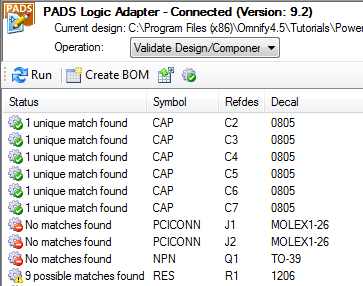
The Results list will display all loaded components, the View Used to find matches (based on symbol filters), and the results of the search.
Each component will have the following result options:
 |
Unique Match |
All component properties contain a single match/item in the database |
 |
Multiple Records |
Not enough properties on the component to derive a single match/item in the database |
 |
No match |
Properties on the component do not result in any matches in the database. |
Double-clicking an item in the results list will load the component and switch to the Update Component mode.


Note: you can configure CADKit to ignore components for validation.
Refer to the User Options section for more information on ignoring components.
|
 |
Verifying Designs |
Top |
|
CADKit contains a part verifier as part of the BOM form.
The verifier will load components from a design to the BOM Form window and then search the Omnify database to find matching part numbers.
To launch the Verifier, click the Verify Items button from the Adapter toolbar.

The verifier will read all components in the Logic schematic and create a BOM form window.
When loading the BOM, the system will determine the Part Number for each component based on the Attribute settings.
Refer to the Attributes section for more information on identifying Part Numbers from component attributes.
The Results column will display the results of the verification.
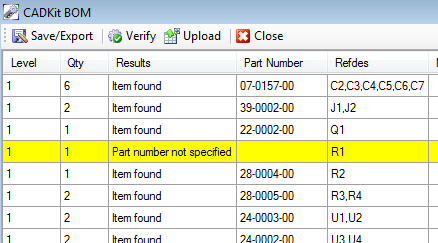
Note: you can configure CADKit to ignore components for verification/BOM generation.
Refer to the User Options section for more information on ignoring components.
|
 |
Creating BOMs |
Top |
|
To create a BOM from a Logic design, click the Create BOM button from the Adapter toolbar.
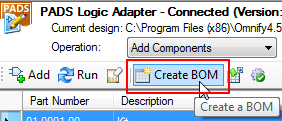
This will read all components in the current design and create a BOM window listing all components.
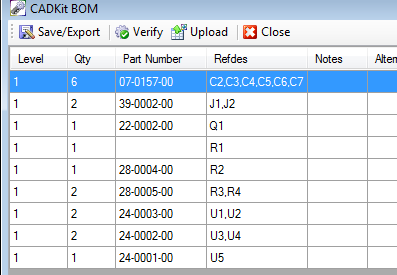
When loading the BOM, the system will determine the Part Number for each component based on the Attribute settings.
Refer to the Attributes section for more information on identifying Part Numbers from component attributes.
Once the BOM is created, you can save the BOM to various formats as well as Upload the BOM to Omnify.
Refer to the BOM Form section for more information on BOM functions.
Note: you can configure CADKit to ignore components for verification/BOM generation.
Refer to the User Options section for more information on ignoring components.
|
|